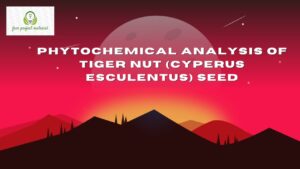ABSTRACT
The study aimed at evaluating the Anti-nutrients composition of Jackfruit Rind, Pulp, Rag and Seed. The Jackfruit was purchased at Akpanadem Market, Aka Itiam Road, in Uyo Local Government Area, Akwa Ibom State, Nigeria. Anti-nutrients composition was evaluated using standard methods. Jackfruit Rind was higher in Oxalate (7.46 ± 0.028) and Tannin (3.637 ± 0.0056) while the seed was higher also in Oxalate (10.195 ± 0.0509), Phytate (1.889 ± 0.002) and Hydrogen Cyanide (HCN) (0.115 ± 0.0026). The fruit parts with low level of anti-nutrient could serve as supplementary sources of essential nutrient to man and livestock.
TABLE OF CONTENTS
Title page – – – – – – – – – i
Certification – – – – – – – – ii
Dedication – – – – – – – – – iii
Acknowledgement – – – – – – – iv
Abstract – – – – – – – – – v
Table of Contents – – – – – – – – vi-vii
CHAPTER ONE: INTRODUCTION
1.1 Background of the Study – – – – – 1-2
1.2 Aim and Objectives of the Study – – – – 2
1.2.1 Aim of the Study – – – – – – – 2
1.2.2 Objectives of the Study – – – – – 2
1.3 Scope and Limitations of the Study – – – – 2
1.4 Definition of Terms – – – – – – 3
CHAPTER TWO: LITERATURE REVIEW
2.1 Description of Jackfruit – – – – – – 5
2.2 History and Geographical Distribution of Jackfruit – 6-7
2.3 Cultivation of Jackfruit – – – – – – 7-10
2.4 Uses of Different parts of Jackfruit – – – – 10-13
2.5 Health Benefits of Jackfruit – – – – – 14-18
2.6 Anti-nutrients – – – – – – – 19
2.6.1 Phytates – – – – – – – – 19-20
2.6.2 Tannins – – – – – – – – 20
2.6.3 Oxalates – – – – – – – – 20-21
2.6.4 Trypsin Inhibitors – – – – – – – 22
2.6.5 Lectins – – – – – – – – 22-23
CHAPTER THREE: MATERIALS AND METHODS
3.1 Materials – – – – – – – – 24
3.2 Method – – – – – – – – 24
3.2.1 Sample Collection – – – – – – 24
3.2.2 Preparation – – – – – – – – 25
3.3 Digestion of Sample – – – – – – 25
3.3.1 Determination of Anti-nutrient – – – – 25
3.4 Determination of Anti-nutrient/Analysis of Antinutrients – 25
3.4.1 Determination of Tannins – – – – – 25
3.4.2 Determination of Hydrocyanide – – – – 26
3.4.3 Determination of Phytate – – – – 27
3.4.4 Determination of Oxalates – – – – 27-29
CHAPTER FOUR: RESULTS AND DISCUSSION
4.1 Results – – – – – – – 30-31
4.2 Discussion – – – – – – – 32-34
CHAPTER FIVE: CONCLUSION AND RECOMMENDATION
5.1 Conclusion – – – – – – – – 35
5.3 Recommendation – – – – – – 35-36
References
CHAPTER ONE: INTRODUCTION
1.1 Background of the Study
The Jackfruit (Artocarpus heterophylla) commonly called “Langka or Nangka” is a species of tree in the Artocarpus genus of the mulberry family (Moraceae). It is one of the popular fruit species in the Philippines. This is manifested by its wide distribution and cultivation. In Eastern Visayas production has steadily increased through the years which enable it to ship to other regions and major cities like Cebu and Manila some 100 to 300 fruits approximately two (2) to three (3) tons per week.
Every part of the jackfruit tree has its respective uses. The immature fruit is used as a vegetable and feeds while the mature fruit is used for desserts and it is processed into beverages and sweets. Its trunk is used as a lumber for houses and building materials. The leaves of this fruit are used as a medicine, fodder and as a compost material. Its latex is in the list of ingredients for glue and paste. Its roots are used for handle of farm implements’. The seed is used for food, also used in feeds, used for planting materials and for making candies. But none has studied the Anti-nutritional factors of the four major parts of Artocarpus heterophylla (Jagadesh et al., 2007).
1.2 Aim and Objectives of the Study
1.2.1 Aim of the Study
The main aim of this study is to assess the anti-nutritional factors (tannins, phytate, hydrocyanide, and oxalate) found in jackfruit seeds, pulp, rag and skin/rind respectively.
1.2.2 Objectives of the Study
To achieve the aim source of jackfruit processing, the fruit was taken to the Lab, washed and cut open into four portions and each was separated into its four major parts.
The anti-nutrient activities of the four major parts (Rind, Pulp, Rag and Seed) of Jackfruit were analyzed.
1.3 Scope and Limitations of the Study
This study is conducted in Akwa Ibom State Polytechnic, situated at Ikot Osurua, Ikot Ekpene Local Government Area, Akwa Ibom State, Nigeria. The Study solely focused on the anti-nutritional factors of jackfruit (Rind, Pulp, Rag and Seed) contained in it.
This study was limited by time, financial constraints and availability of research equipment.
1.4 Definition of Terms
Anti-nutrients are natural or synthetic compounds that interfere with the absorption of nutrients in the body\
Anti-nutritional factors can be defined as those substances generated in natural food substances by the normal metabolism of species and by different mechanisms. Eg. Phytic acid, Tannins, Hydrogen Cyanide and Oxalate.
Artocarpus heterophylla also known as Jacktree is a species of tree in the fig, mulberry and breadfruit family (Moroceae).
Phytic acid is an antioxidant that is mainly found in grains, nuts and seeds.
Hydrogen cyanide is a colorless or pale-blue liquid organic compound with a bitter, almond-like odour. HCN interferes with the body’s use of oxygen and may cause harm to the brain, heart, blood vessels and lungs.
Oxalate or Oxalic acid is an organic compound found in many plants, including leafy greens, vegetables, fruits, cocoa, nuts and seeds.
Tannins are water-soluble polyphenols that are present in many plant foods, including cider, peas, legume seeds, coffee.



